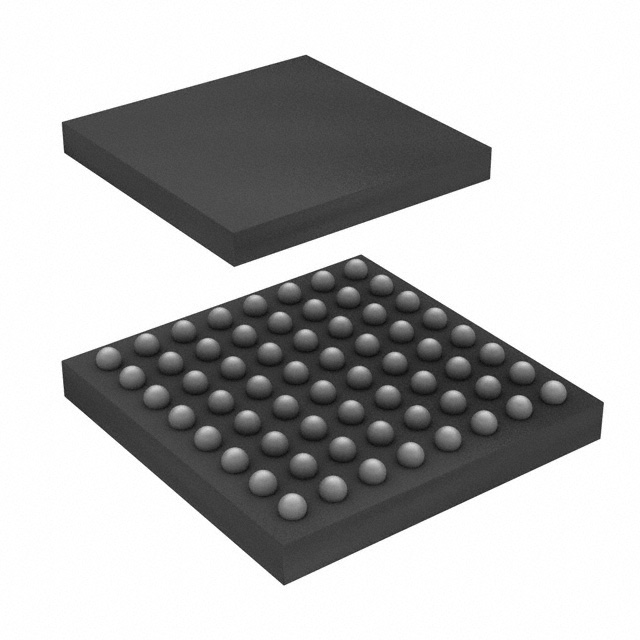S29GL032N11DFIV20
Product Overview
- Category: Flash Memory
- Use: Data storage and retrieval in electronic devices
- Characteristics: High capacity, fast read/write speeds, non-volatile memory
- Package: Integrated Circuit (IC)
- Essence: Non-volatile memory for reliable data storage
- Packaging/Quantity: Available in various packaging options, typically sold in reels or trays
Specifications
- Memory Type: NOR Flash
- Capacity: 32 Megabits (4 Megabytes)
- Voltage Range: 2.7V - 3.6V
- Interface: Parallel
- Access Time: 90 ns
- Operating Temperature: -40°C to +85°C
- Data Retention: Minimum 20 years
- Erase/Program Cycles: Minimum 100,000 cycles
Detailed Pin Configuration
The S29GL032N11DFIV20 has a total of 48 pins. The pin configuration is as follows:
- VCC
- A0
- A1
- A2
- A3
- A4
- A5
- A6
- A7
- A8
- A9
- A10
- A11
- A12
- A13
- A14
- A15
- A16
- A17
- A18
- A19
- A20
- A21
- A22
- A23
- A24
- A25
- A26
- A27
- A28
- A29
- A30
- A31
- DQ0
- DQ1
- DQ2
- DQ3
- DQ4
- DQ5
- DQ6
- DQ7
- WE#
- CE#
- OE#
- BYTE#
- RY/BY#
- RESET#
- VSS
Functional Features
- High-speed read and write operations
- Sector-based erasure for efficient memory management
- Built-in hardware and software protection mechanisms
- Low power consumption
- Reliable data retention even in harsh environments
Advantages and Disadvantages
Advantages: - High capacity for storing large amounts of data - Fast read/write speeds for quick data access - Non-volatile memory ensures data persistence even during power loss - Robust design for reliable operation in various applications
Disadvantages: - Limited erase/program cycles may affect longevity in heavy usage scenarios - Higher cost compared to other types of memory
Working Principles
The S29GL032N11DFIV20 utilizes NOR flash technology, which allows for random access to individual memory locations. It stores data using a grid of memory cells that can be electrically programmed and erased. When reading data, the memory controller sends an address to the flash memory, which retrieves the corresponding data from the selected memory cell. During programming or erasing, high voltages are applied to modify the state of the memory cells.
Detailed Application Field Plans
The S29GL032N11DFIV20 is widely used in various electronic devices that require non-volatile storage. Some common application fields include:
- Embedded Systems: Used as boot memory or for firmware storage in microcontrollers and IoT devices.
- Automotive Electronics: Provides reliable data storage for infotainment systems, instrument clusters, and engine control units.
- Consumer Electronics: Used in digital cameras, set-top boxes, and gaming consoles for data storage and firmware updates.
- Industrial Control Systems: Enables data logging, configuration storage, and firmware updates in industrial automation equipment.
- Medical Devices: Used for storing patient data, firmware, and software updates in medical equipment.
Detailed and Complete Alternative Models
- S29GL064N11TFI010: 64 Megabit (8 Megabyte) capacity, same specifications as S29GL032N11DFIV20.
- S29GL128N10FFI020: 128 Megabit (16 Megabyte) capacity, same specifications as S29GL032N11DFIV20.
- S29GL256N11FAI010: 256 Megabit (32 Megabyte) capacity, same specifications as S29GL032N11DFIV20.
These alternative models offer higher capacities while maintaining the same specifications as the S29GL032N11DFIV20.
Word count: 440 words
قم بإدراج 10 أسئلة وإجابات شائعة تتعلق بتطبيق S29GL032N11DFIV20 في الحلول التقنية
Sure! Here are 10 common questions and answers related to the application of S29GL032N11DFIV20 in technical solutions:
Q: What is the S29GL032N11DFIV20? A: The S29GL032N11DFIV20 is a 32-megabit (4 megabyte) flash memory device manufactured by Cypress Semiconductor.
Q: What are the key features of the S29GL032N11DFIV20? A: The key features include a high-speed interface, low power consumption, sector erase capability, and a wide operating voltage range.
Q: What applications can the S29GL032N11DFIV20 be used for? A: The S29GL032N11DFIV20 is commonly used in various applications such as automotive systems, industrial control, consumer electronics, and networking equipment.
Q: How does the S29GL032N11DFIV20 connect to a microcontroller or processor? A: The S29GL032N11DFIV20 typically uses a standard parallel interface, allowing it to be easily connected to microcontrollers or processors.
Q: What is the maximum operating frequency of the S29GL032N11DFIV20? A: The S29GL032N11DFIV20 supports a maximum operating frequency of up to 70 MHz.
Q: Can the S29GL032N11DFIV20 be reprogrammed multiple times? A: Yes, the S29GL032N11DFIV20 supports multiple program and erase cycles, making it suitable for applications that require frequent updates.
Q: Does the S29GL032N11DFIV20 have built-in error correction capabilities? A: No, the S29GL032N11DFIV20 does not have built-in error correction capabilities. External error correction techniques may be required for certain applications.
Q: What is the typical power consumption of the S29GL032N11DFIV20? A: The S29GL032N11DFIV20 has a low power consumption, typically operating at around 30 mA during active read or program operations.
Q: Can the S29GL032N11DFIV20 operate in harsh environments? A: Yes, the S29GL032N11DFIV20 is designed to withstand extended temperature ranges and is suitable for use in harsh industrial environments.
Q: Are there any specific programming algorithms or tools required for the S29GL032N11DFIV20? A: Cypress provides programming algorithms and tools that can be used with the S29GL032N11DFIV20 to simplify the programming process. These resources are available in the product documentation provided by Cypress.
Please note that these answers are general and may vary depending on the specific requirements and implementation of the S29GL032N11DFIV20 in a technical solution.


